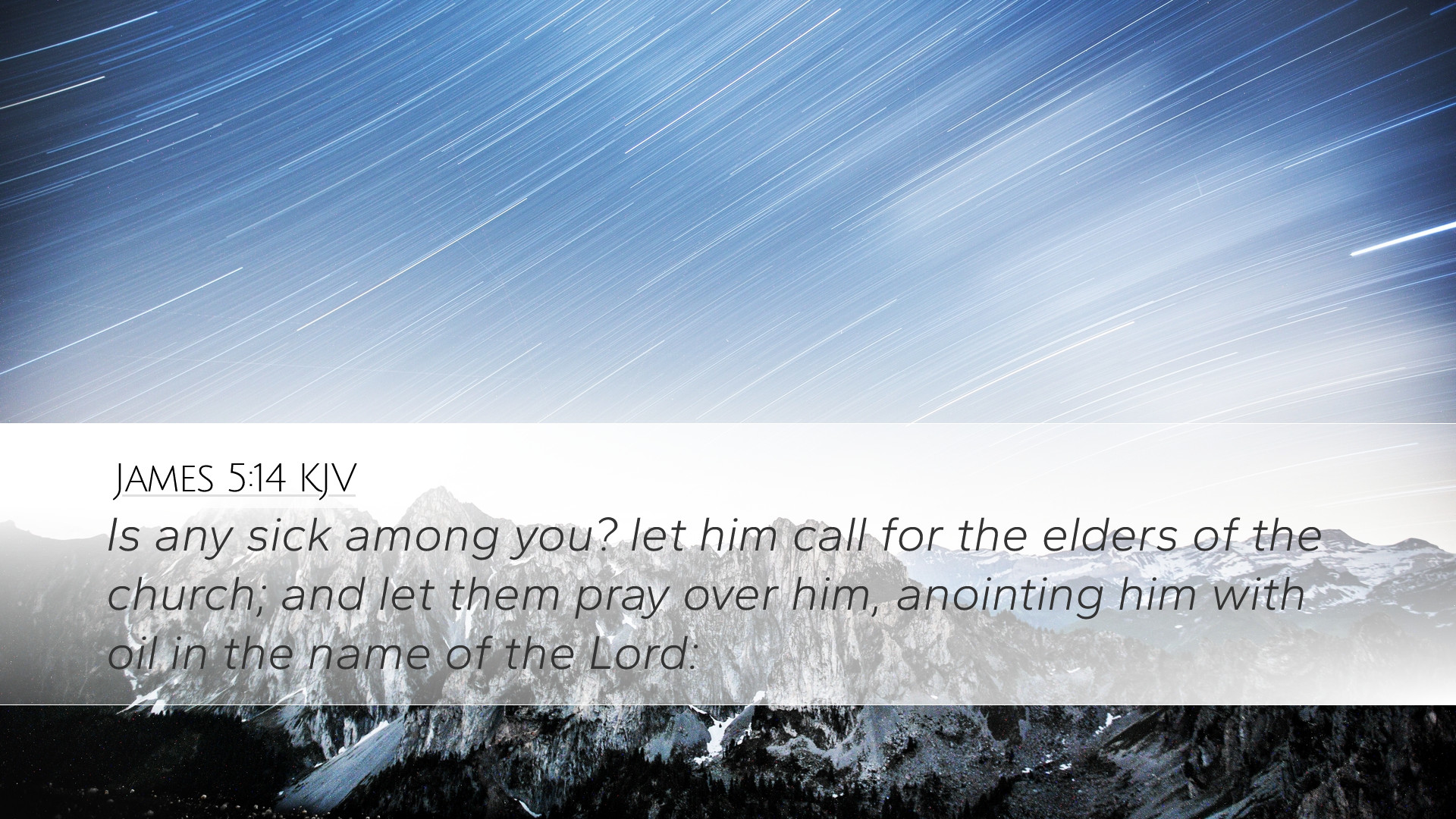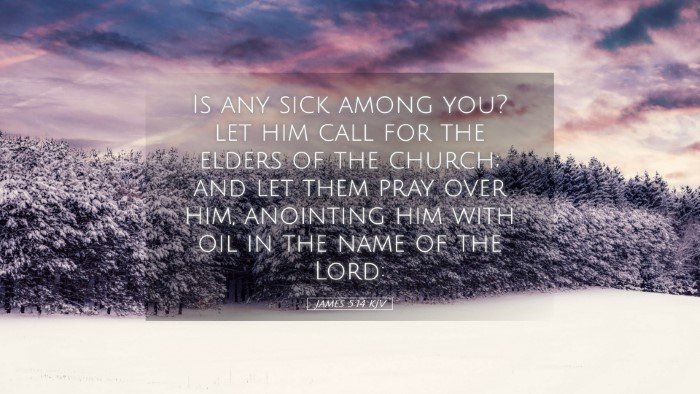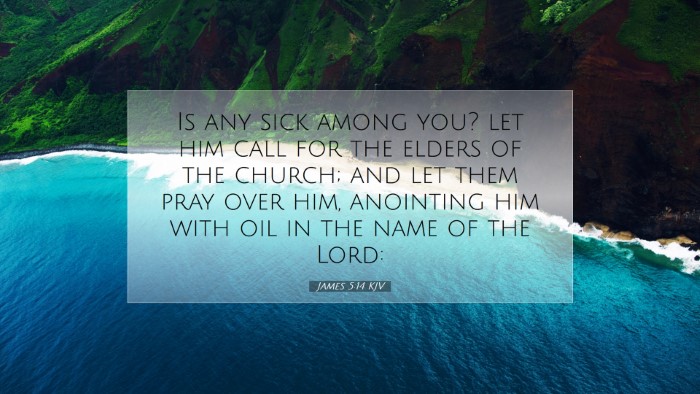Old Testament
Genesis Exodus Leviticus Numbers Deuteronomy Joshua Judges Ruth 1 Samuel 2 Samuel 1 Kings 2 Kings 1 Chronicles 2 Chronicles Ezra Nehemiah Esther Job Psalms Proverbs Ecclesiastes Song of Solomon Isaiah Jeremiah Lamentations Ezekiel Daniel Hosea Joel Amos Obadiah Jonah Micah Nahum Habakkuk Zephaniah Haggai Zechariah MalachiJames 5:14
James 5:14 KJV
Is any sick among you? let him call for the elders of the church; and let them pray over him, anointing him with oil in the name of the Lord:
James 5:14 Bible Commentary
Commentary on James 5:14
Verse: "Is any sick among you? let him call for the elders of the church; and let them pray over him, anointing him with oil in the name of the Lord."
Introduction
The letter of James is a profound epistle, providing practical instruction to believers. Chapter 5 specifically addresses matters of faith in action, including healing and the ministry of the elders within the church. This verse encapsulates a critical aspect of church life—requesting divine intervention for physical ailments.
Contextual Setting
James, writing to the twelve tribes scattered abroad, emphasizes the need for a practical application of faith. Illness can be both physically and spiritually debilitating, and the community's response is crucial in addressing these challenges.
The Role of the Elders
According to Matthew Henry, the elders are those who bear the responsibilities of spiritual leadership (Henry). They hold a significant role in pastoral care, suggesting that the collective prayer of the church is powerful. Albert Barnes highlights that the elders represent the authority and experience needed for such spiritual matters (Barnes). This invocation implies that the church is a community where members intercede for one another, reinforcing the interconnectedness of the Body of Christ.
Prayer and Healing
The act of prayer is foundational to a believer's life. Adam Clarke interprets this as not merely a ritual but a deeply relational dialogue with God (Clarke). The anointing with oil signifies a tangible act of faith and trust in God's power to heal. This practice is rooted in the Jewish tradition and carries both symbolic and practical significance—anointing is often associated with divine choice and empowerment.
Spiritual Implications
Engaging the elders for prayer underscores the humility and submission within the church structure. It fosters a culture where congregants are encouraged to seek help, recognizing their dependence on God and each other (Henry). This approach counters the prevalent individualism in modern society.
The Nature of Sickness
James refers to a specific type of sickness that may require the attention of the elders. The nature of the illness can vary, encompassing both physical ailments and possibly spiritual ailments, as highlighted by Clarke (Clarke). Sickness in the biblical sense is often intertwined with deeper theological concepts, such as sin and the need for redemption. Thus, prayer and anointing serve not just as requests for physical healing but as avenues for spiritual restoration.
Practical Application for Today
The directives found in James 5:14 prompt contemporary church leaders to foster environments where members feel safe to present their needs. This is vital for both spiritual and emotional health. Pastors, students, and theologians can learn from this model as they strive to cultivate community-focused practices within their congregations.
Encouraging the Ministry of Healing
- Empower Leaders: Equip elders and leaders to pray and minister effectively, understanding the biblical framework of prayer for healing.
- Build Community: Encourage open communication about health and spiritual well-being, ensuring that members are comfortable seeking help.
- Integrate Prayer in Worship: Include prayer for the sick in regular services, creating a culture of intercession within the church.
Theological Reflection
James 5:14 invites deeper theological reflection on the relationship between faith, healing, and community. This verse challenges believers to consider how they view suffering and the means through which God provides relief. As Matthew Henry states, prayer, accompanied by faith, can bring about miraculous transformations (Henry). Prayer is thus not an end but a means through which God’s will and purposes unfold.
Furthermore, it raises questions about the nature of healing. Is it solely physical, or does it encompass emotional and spiritual dimensions as well? As identified by Adam Clarke, this multidimensional view of healing aligns with the holistic approach found throughout Scripture (Clarke).
Conclusion
James 5:14 serves as a crucial reminder for the church about the power of prayer, the importance of community, and the role of spiritual leaders in facilitating both healing and support. The traditions established in this verse continue in relevance, urging believers to seek God's intervention through collective prayer. For pastors, students, and theologians, this passage is foundational in understanding how faith manifests through community and shared burdens.


